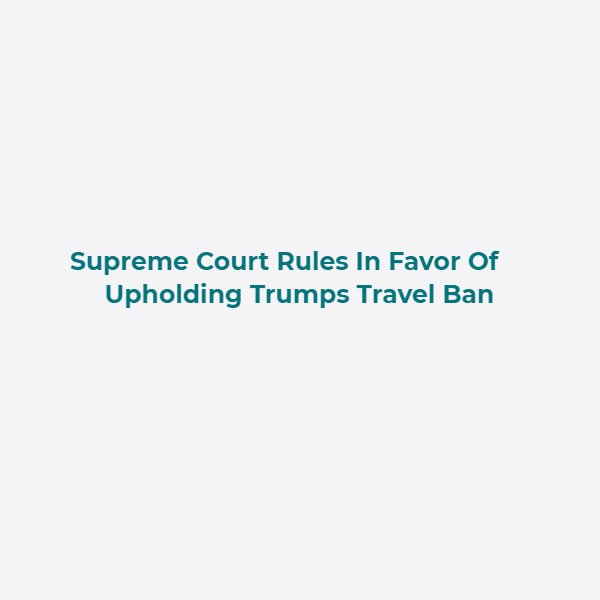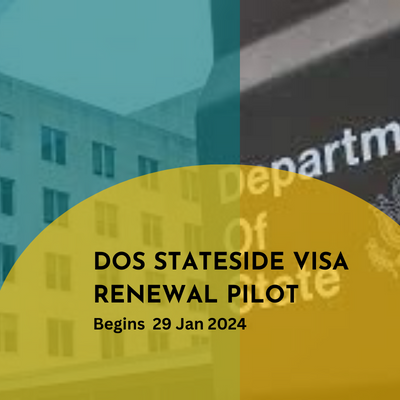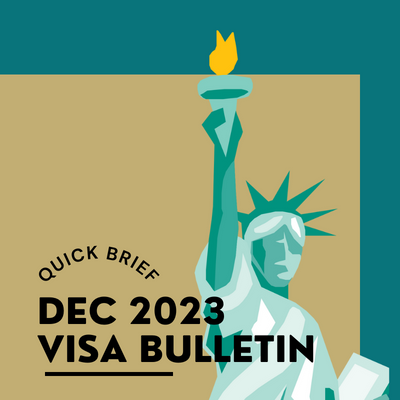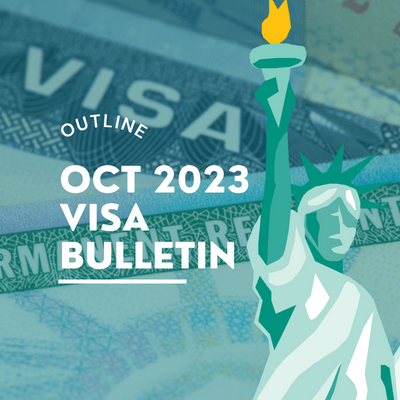On June 26, 2018, in a 5-4 decision, the United States Supreme Court ruled to uphold Proclamation No. 9645, commonly known as the Travel Ban. In doing so, the Supreme Court overturned the decision of the Hawaii district court, which happened in March 2017 in the case TRUMP v. HAWAII, in which the Hawaii district court placed a temporary restraining order on the travel ban policy as the court judged that the policy was motived by anti-Islam sentiment and was in breach of the Establishment Clause.
Brief History of the Travel Ban
The Proclamation 9645 is the third rendition of the travel ban, with the first being the Executive Order 13769, which was signed on January 27, 2017. The major points of this executive order included
a) Suspension the U.S. Refugee Program (USRAP) for four months (120 days),
b) Placement of limitations of entry into the U.S. of foreign nationals of Iraq, Iran, Somalia, Libya, Syria, Sudan and Yemen.
c) Suspension of the admission of refugees from Syria.
Prioritization of refugee claims by foreign nationals belonging to minority religions.
1) Capping the number of refugees allowed into the United States for FY2017.
2) Other Provisions.
This executive order caused up to 60,000 visas to be temporarily revoked, and the detainment of over 700 travelers. The executive order was widely criticized and challenged. On February 3, 2017, a temporary restraining order was placed on several portions of the executive order in the case of Washington v. Trump. This led to the issuance of the second travel ban – Executive Order 13780 on March 6, 2017. President Trump referred to the second travel ban as “watered down, politically correct version” of the first ban. Major points of the executive order 13780 included –
a) Replacement and revoke of Executive Order 13769
b) Suspension the U.S. Refugee Program (USRAP) for four months (120 days)
c) Placement of limitations of entry into the U.S. of foreign nationals of Iran, Somalia, Libya, Syria, Sudan and Yemen for 90 days minimal
d) Suspension of the admission of refugees for 120 days
e) Other Provisions.
This new executive order was restrained by a temporary restraining order issued by Judge Derrick Watson of the United States District Court for the District of Hawaii, which stopped the government from enforcing several provisions of the order. The Supreme Court partially upheld the executive order on June 26, 2017, in response to an appeal by the Trump administration. The third rendition of the travel ban came on September 24, 2017. Called the Presidential Proclamation 9645, this proclamation expanded on and defined the previous executive order. Under this proclamation, countries affected by the ban include Chad, Libya, Iran, North Korea, Syria, Somalia, Venezuela, and Yemen. Sudan, which was present in the previous executive order, was removed. In April 2018, Chad was removed from the list of nations affected by the ban, as the nation met “the baseline security standard of the United States”.
On June 26, 2018, Supreme Court ruled to uphold the Proclamation No. 9645.
Chief Justice John Roberts gave the majority opinion joined by Justice Samuel Alito, Justice Neil Gorsuch, Justice Clarence Thomas, and Justice Anthony Kennedy. Justice Clarence Thomas and Justice Anthony Kennedy, in addition, filed concurring opinions. Justice Sonia Sotomayor also filed a dissenting opinion joined by Justice Ruth Bader Ginsburg. Justice Stephen Breyer filed a dissenting opinion, in which Justice Elena Kagan joined.
Reasoning behind Ruling
According to Chief Justice John Roberts, two main issues were the focus of the ruling these include
- Whether the president of the United States exceeds his authority under the INA (Immigration and Nationality Act) and to implement entry restrictions on foreign nationals.
- And whether this policy infringes on the Establishment Clause of the First Amendment. That is to say, if it was motivated by religious bias.
Does President Trump exceed his authority under the INA? As according to the majority opinion delivered by Chief Justice Roberts, the Supreme Court rules that the restrictions imposed were in fact within the core executive responsibility and that the Supreme Court does not have the necessary competence needed to substitute its own judgment for the resident’s when it comes to matters of national security. Moreover, given the administration’s worldwide, multi-agency review process, the waivers and exemptions included in the proclamation, the proclamation can reasonably be comprehended be as a result of a justification independent of unconstitutional grounds.
Not every Justice agreed, Justice Breyer dissented focusing on the waiver program and other exemptions of the proclamation. He cited anecdotal evidence, selective statistics, and a declaration from unrelated litigation as evidence that not enough foreign nationals are benefiting from the exemptions or the waivers.
Does the Proclamation violate the Establishment Clause of the First Amendment? The argument that religious hostility against Islam is one of the factors that motived this proclamation was considered. The respondents claimed that the proclamation was not motivated by national security concerns but by animus towards Muslims. The government, in turn, argued that although many of the nations the ban is imposed on are Muslim-majority counties, the majority of Muslim-majority countries are not subject to the restrictions. The court, therefore, decided that the restrictions are facially neutral toward religion. Justice Robert drew attention to the fact that the proclamation covered only 8 per cent of the global Muslim population, and included countries that in the past have been designated by past administrations or Congress as posing a national security threat. In addition, Justice Robert expressed that three Muslim majority countries have also been removed from the policy.
Countries Affected By the Proclamation
Although according to the proclamation, foreign nationals of almost all the countries restricted by the travel ban are permitted to enter the United States on a variety of nonimmigrant visas, only certain foreign nationals on particular nonimmigrant and immigrant statuses can gain entry into the U.S.
Currently, affected countries include Iran, Libya, Yemen, Syria, North Korea, Somalia, and Venezuela.
- Iran – with the exception of nonimmigrants on the F and M statuses (student visa categories), and exchange visitors on the J visa status, nonimmigrants and immigrants will not be allowed entry in the United States.
- Somalia – Immigrants are suspended from entering the U.S., nonimmigrants will be subjected to additional scrutiny.
- Syria and North Korea – Entry into the United States by immigrants or nonimmigrants have been suspended.
- Venezuela – the proclamation limits entry of certain government officials, and their immediate family members on nonimmigrant business and tourist visa.
- Yemen and Libya – The proclamation suspends restrict entry for immigrants and nonimmigrants on business and tourist nonimmigrant visas which include the B- 1 (business visa), the B-2(tourist visa), and the B-1/B-2 (business/tourist visa).
Also, the proclamation exempts the following – lawful permanent residents, foreign nationals granted asylum or refugees, those with certain travel documents, parolees, Representatives of governments or international organizations, dual nationals of noncovered countries.
Conclusion :
In concluding the majority opinion, Chief Justice Roberts expressed that three added features to the entry policy support the government’s claim that the proclamation is of legitimate national security. This includes the removal of three Muslim-majority countries – Chad, Sudan and Iraq from the list of restricted countries since the introduction of the travel ban in January 2017. Secondly, with the countries still under entry restriction, several exceptions have been made to several visa categories such as allowing persons with F, J and M visa statuses from Iran, and other nations under the ban entry into the United States. Thirdly, the waver program created by the proclamation is available to all applied to those seeking nonimmigrant or immigrant entry into the U.S. As such, “the Government has set forth a sufficient national security justification to survive rational basis review.”
Relevant news:
- Federal Judges Halt Donald Trump’s Revised Travel Ban
- US President Donald Trump Signs New Travel Ban Executive Order
- Donald Trump Travel Ban: Developments Regarding President Donald Trump’s Travel Ban
- Donald Trump’s Travel ban: U.S Supreme Court Partially Upholds the Travel Ban
Sources :
- Supreme Court of the United States. (2018). 17-965 Trump v. Hawaii (06/26/2018). The White House: The Office of the Press Secretary. (2018). Statement by the Press Secretary Regarding the Presidential Proclamation to Lift Entry Restrictions for Nationals of the Republic of Chad.
- DOS. (2017). Revisions to Presidential Proclamation 9645.
- Federal Register. (2017). Executive Order 13780 – Protecting the Nation From Foreign Terrorist Entry Into the United States.
- Federal Register. (2017). Proclamation 9645 – Enhancing Vetting Capabilities and Processes for Detecting Attempted Entry Into the United States by Terrorists or Other Public-Safety Threats. [ONLINE]
- Trump, D. (2017) 5 Jun
- Department of Justice. (2017). Statement by Attorney General Jeff Sessions on the Ninth Circuit Decision.
- United States Court of Appeals for the Ninth Circuit. (2017). Appeal from the United States District Court for the District of Hawai‘i Derrick Kahala Watson, District Judge, Presiding.
- The White House: The Office of the Press Secretary. (2017). Press Briefing by Press Secretary Sean Spicer and Secretary of Labor Alex Acosta, 6/12/2017, #54. [ONLINE]






